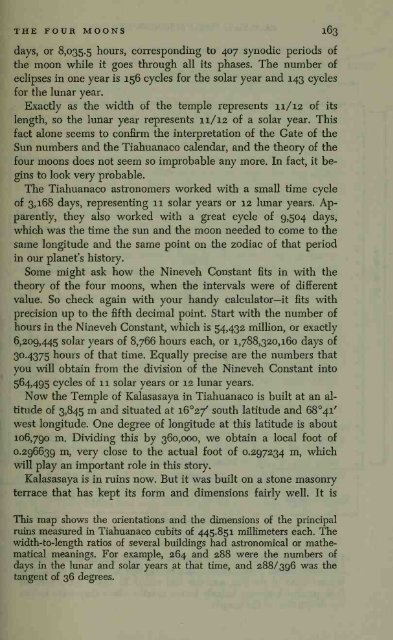Create successful ePaper yourself
Turn your PDF publications into a flip-book with our unique Google optimized e-Paper software.
THE FOUR MOONS 163<br />
days, or 8,035.5 hours, corresponding to 407 synodic periods of<br />
the moon while it goes through all its phases. The number of<br />
eclipses in one year is 156 cycles for the solar year and 143 cycles<br />
for the lunar year.<br />
Exactly as the width of the temple represents 11/12 of its<br />
length, so the lunar year represents 11/12 of a solar year. This<br />
fact alone seems to confirm the interpretation of the Gate of the<br />
Sun numbers and the Tiahuanaco calendar, and the theory of the<br />
four moons does not seem so improbable any more. In fact, it begins<br />
to look very probable.<br />
The Tiahuanaco astronomers worked with a small time cycle<br />
of 3,168 days, representing 11 solar years or 12 lunar years. Apparently,<br />
they also worked with a great cycle of 9,504 days,<br />
which was the time the sun and the moon needed to come to the<br />
same longitude and the same point on the zodiac of that period<br />
in our planet's history.<br />
Some might ask how the Nineveh Constant fits in with the<br />
theory of the four moons, when the intervals were of different<br />
value. So check again with your handy calculator—it fits with<br />
precision up to the fifth decimal point. Start with the number of<br />
hours in the Nineveh Constant, which is 54,432 million, or exactly<br />
6,209,445 solar years of 8,766 hours each, or 1,788,320,160 days of<br />
30.4375 hours of that time. Equally precise are the numbers that<br />
you will obtain fiom the division of the Nineveh Constant into<br />
564,495 cycles of 11 solar years or 12 Ixmar years.<br />
Now the Temple of Kalasasaya in Tiahuanaco is built at an altitude<br />
of 3,845 m and situated at i6°2/ south latitude and 68°4i'<br />
west longitude. One degree of longitude at this latitude is<br />
about<br />
106,790 m. Dividing this by 360,000, we obtain a local foot of<br />
0.296639 m, very close to the actual foot of 0.297234 m, which<br />
will play an important role in this story.<br />
Kalasasaya is in ruins now. But it was built on a stone masonry<br />
terrace that has kept its form and dimensions fairly well. It is<br />
This map shows the orientations and the dimensions of the principal<br />
ruins measured in Tiahuanaco cubits of 445.851 millimeters each. The<br />
width-to-length ratios of several buildings had astronomical or mathematical<br />
meanings. For example, 264 and 288 were the numbers of<br />
days in the lunar and solar years at that time, and 288/396 was the<br />
tangent of 36 degrees.

















